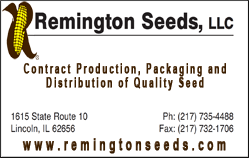|
 Today, central Illinois agriculture with its rich soils has
narrowed its focus more to crop production. According to the
2007 Census of Agriculture, there are 320,356 acres in farmland
in Logan County, with 92 percent reported as harvested cropland. Today, central Illinois agriculture with its rich soils has
narrowed its focus more to crop production. According to the
2007 Census of Agriculture, there are 320,356 acres in farmland
in Logan County, with 92 percent reported as harvested cropland.
The American farmer is first a business person. In an industry
with its product at the indiscriminate mercy of the elements;
with disease and pests to combat; plus keeping abreast of
changing laws, technology, equipment, finances, expanding
markets and the day-to-day of general operations -- today's
farmer must be the most savvy of businessmen.
For most farmers, their motivation goes beyond profits, with the
ultimate aim to provide products the world needs, and the
world's needs are changing.

Last year it was announced that by the year 2050 the world
population is expected to reach 9.1 billion, and with that
increase, food needs are expected to double. Additionally,
continuing research and development are making it possible for
agricultural products to be used in the creation of biofuels,
which aid in reducing the use of limited fossil fuels, resulting
in less pollution and dependence on foreign oil.
"To produce future food, fiber and biofuels and leave room for
wildlife, we must increase production on the land we are now
using. High-yield agriculture benefits the environment by
producing maximum crop yields from a small amount of land." --
National Agricultural Aviation Association
Chuck Holzwarth has dedicated his agricultural career toward
helping farmers reach those higher yields.

Born and raised on a farm, Holzwarth says, "I grew up with a
love for agriculture."
In the late 1980s Holzwarth began flying at a rural airport
where there was an aerial application operation. "Once I started
flying with them, I was hooked," he says.
Chuck Holzwarth's Flying Service began in 1993, providing
agricultural spraying, seeding and fertilizing. He expanded his
business to the Logan County Airport in 1995 and currently
conducts operations in Lincoln, Kilbourne and Virden.
The benefits of aerial application include:
-
No soil compaction.
-
No equipment damage to mature foliage.
-
Timely treatment or sowing when fields are too wet for
tractors.
-
Efficiency -- three times faster than any other application
processes.
-
More effective when timing is critical to treat pests or
disease.
-
Does not contribute to topsoil runoff, reducing soil erosion
by as much as 90 percent.
 Holzwarth began his operation in Lincoln in a large, open-ended
Quonset at the airport's north end. The business grew rapidly,
and with technology advancements, it has undergone several major
expansions.
In 2000, Holzwarth built his own large hangar. It housed his
aircraft, state-of-the-art chemical loading systems, cleaning
systems, storage, office and a small rest area.
For central Illinois farmers, the year 2006 was a busy one
combating pests. Holzwarth brought in additional aerial
applicators, and there were as many as 13 planes a day working
over Logan County's crops much of the season.
The following year, he decided to build a separate office
building that would allow more orders to be processed. It also
included a kitchen and conference area.
The two buildings and equipment represented an investment of
more than $400,000, and that did not include the planes.
[to top of second column] |

In 2006, the business made crop applications on over
100,000 acres. Since 2007, Holzwarth has been providing service
on over half a million acres each year.
Corn and soybeans represent the greatest portion of the crop
work. But, the business also provides wheat, alfalfa and green
bean crop services.
Holzwarth's application season typically begins in April,
spraying winter crops, and ends in late September, seeding
winter cover crops. But he is kept busy year-round with
planning, training, renewing certifications and ordering; and
his planes get additional maintenance, upgrades and inspections
during the offseason.
The busy season ramps up about the end of June, when pollination
begins. In July he has five to six planes running all day, with
one of his Air Tractors either taking off or landing every five
minutes from sunup to sundown.

The turbine-powered Air Tractors he uses are fully loaded for
the most accurate application and are well-known for
reliability.
Onboard recording equipment combines global positioning and
geographic information systems that work in conjunction with
flow controls, real-time meteorological systems (for drift
control) and precisely calibrated spray equipment to provide
accuracy in applying the correct amount of product.
The guidance system provides application precision. If chemical
runs out in midfield, that place is automatically marked by the
in-plane mapping system, and when the pilot returns, he knows
exactly where to begin again, Holzwarth said.
In the office, an "as applied" map is generated for the
customer, showing the accuracy of treatment to their fields.

Holzwarth runs the business with his wife, Linda. The business
also relies on several other pilots, office assistants and
hangar crew. To meet demands and keep things running smoothly
during high season, additional pilots and help may be called in.
The Illinois farmer is always looking for best practices for his
or her chosen production. Aerial application not only offers
benefits when crop products are applied efficiently and
effectively, but the environment is also benefited by producing
maximum crop yields from fewer acres.
[Jan Youngquist]This is one of the
articles you will find in our special Spring 2012 Farm Outlook
Magazine.
The magazine is online now.
Click here to view all the articles, which include:
Introduction by John Fulton
Weather: The biggest variable
2011 crop yields
Productivity: Corn-on-corn
Alternative income
Protecting your income with insurance
The value of land conservation
Property taxes on farmland
Land value in Logan County
Increasing yield with aerial application
The importance of Ag Scholarships

|